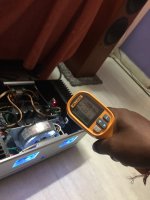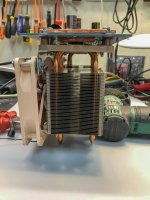It's pretty hot, but if too hot, reduce the quiescent by increasing the active CCS resistor.
You might find pretty much any 4R speaker will be fine with a little less quiescent.
Hugh
You might find pretty much any 4R speaker will be fine with a little less quiescent.
Hugh
It's pretty hot, but if too hot, reduce the quiescent by increasing the active CCS resistor.
You might find pretty much any 4R speaker will be fine with a little less quiescent.
Hugh
Thanks Hugh, any recommendation on the CCS resistor value? Would that impact sound quality, as current sound signature i liked most of all the amps i listened in my setup
Regards
Raj
I think you have about 0.22R at present?
Increase by 15%, that will reduce heat considerably.
Hugh
Increase by 15%, that will reduce heat considerably.
Hugh
I think you have about 0.22R at present?
Increase by 15%, that will reduce heat considerably.
Hugh
Yes am using 0.22
Your case and heatsinks are in general, too small for a Class A amp of this power. 65 C is ok for part but the case will burn you if you hold it mode than a few seconds. Try adding an external Noctua PWM fan. That’s the easiest thing to do. Use the speed reducer adapter - it will be inaudible.
XRK and Hugh,
I also had discussed with Rajesh about the heatsink temperature, couple of points to note.
1. Temperature reading he shows (63) I think is of mosfet body. The heatsink temperature is around 57C.
2. Ambient temperature is around 33C. So delta is around 25C (to heatsink).
Do you think it is fine to use with above details?
Thanks
Balaji
I also had discussed with Rajesh about the heatsink temperature, couple of points to note.
1. Temperature reading he shows (63) I think is of mosfet body. The heatsink temperature is around 57C.
2. Ambient temperature is around 33C. So delta is around 25C (to heatsink).
Do you think it is fine to use with above details?
Thanks
Balaji
Your case and heatsinks are in general, too small for a Class A amp of this power. 65 C is ok for part but the case will burn you if you hold it mode than a few seconds. Try adding an external Noctua PWM fan. That’s the easiest thing to do. Use the speed reducer adapter - it will be inaudible.
Marginal but acceptable. You may have mosfet failure within about two years.
However use a fan. IT DOES NOT TO BE SPINNING FAST!
HD
However use a fan. IT DOES NOT TO BE SPINNING FAST!
HD
Yes, 57C is ok - but toasty if you touch it. You might just try a cheap $4 80mm 12v
Dc pc fan with 3W 100R series resistor to slow it down. Use a wall wart 12v Class 2 linear supply to power the fan. It increases cooling by maybe 10x more effective.
Dc pc fan with 3W 100R series resistor to slow it down. Use a wall wart 12v Class 2 linear supply to power the fan. It increases cooling by maybe 10x more effective.
I Already have the two channels mounted. I have tested Them with two 10th Chinese commutated sources each and to test they Are worth. I get on the exits 10mv and 1MV respectively and without any noise. Here are some pictures of the process. And test to see if they worked. Now It's my turn to make the power supplies and the real ones for the speakers. Sound is good for now. The test I made a +-33v and the temperature in the radiators was about 42 degrees centigrade. The ambient temperature was 22 degrees in the test and the fans are very quiet too
Attachments
-
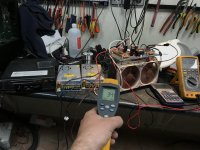 BE29D27C-0533-4E3F-B90B-936DBED5E83A.jpg977.3 KB · Views: 334
BE29D27C-0533-4E3F-B90B-936DBED5E83A.jpg977.3 KB · Views: 334 -
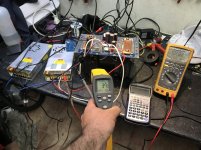 16BA911D-0BFB-4478-A6AA-9641A9E11FB1.jpg995 KB · Views: 360
16BA911D-0BFB-4478-A6AA-9641A9E11FB1.jpg995 KB · Views: 360 -
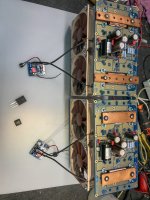 AAFD3628-84BE-4ABB-8A8E-AA6BAD5FFF35.jpg773.5 KB · Views: 330
AAFD3628-84BE-4ABB-8A8E-AA6BAD5FFF35.jpg773.5 KB · Views: 330 -
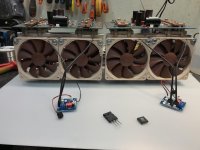 E11B9965-8933-4AC9-96EC-B968668C432E.jpg694.8 KB · Views: 327
E11B9965-8933-4AC9-96EC-B968668C432E.jpg694.8 KB · Views: 327 -
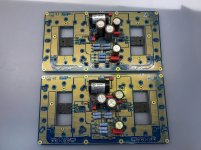 DE3B843D-971F-41AA-85C8-31E0D8FAA9C0.jpg1 MB · Views: 318
DE3B843D-971F-41AA-85C8-31E0D8FAA9C0.jpg1 MB · Views: 318 -
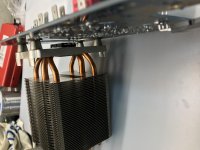 8AF25829-3177-4228-B2A5-E426C30C2608.jpg720.1 KB · Views: 212
8AF25829-3177-4228-B2A5-E426C30C2608.jpg720.1 KB · Views: 212
Outstanding work, Antonio! Very well made and clear photographs of how you went about the project. Thank you for posting your results!
Do you have a metal brace on the mosfet, holding it against the cooling pad? I suspect you have something, but it's not clear in the photo.
Is this the best sound you've had from a Class A?
Ciao,
Hugh
Do you have a metal brace on the mosfet, holding it against the cooling pad? I suspect you have something, but it's not clear in the photo.
Is this the best sound you've had from a Class A?
Ciao,
Hugh
Thank You Hugh. The truth is that it sounds very good. It'S The first Class I have. The others I have are Class AB.
Between the transistor and the copper waistband there is a copper block to push it when tightening the waistband screws. In This Picture it looks better
Between the transistor and the copper waistband there is a copper block to push it when tightening the waistband screws. In This Picture it looks better
Attachments
Nice work Antonio! Great to see someone else using the CPU coolers and Noctua fans. They are a great combo for the 21st Century Class A amp.
Listening Notes
Hugh! Your belief was proved to me last night. I took my ALPHA 20W over to a friend's house to go head to head with his Line Magnetic 211ia integrated tube amp on his Paradigm Studio 60 v5 speakers. I also brought a BAF 2018 Wayne's Linestage and Wayne's WHAMMY headphone amp as pre-amp options. I still don't have my AKSA Lender pre in a proper case, otherwise I would have brought it. I also spent the previous night re-arranging and re-wiring the Alpha for the 4th time to get the hum down even more. I swapped the Antek 4218 for a 4220 which had less audible buzz to it as well.
So after a quick setup session, we listened mostly to jazz, starting with a Joe Henderson CD and a few others. CD sound was good but my friend really wanted to throw on some vinyl. He went with Heavy Weather by Weather Report on vinyl. 'A Remark You Made' was our A/B track. We started with the Line Magnetic then went to Alpha/Wayne's Linestage, then Alpha/WHAMMY combo.
I would have to say the bass attack from the Line Magnetic was very good. It felt a bit more visceral than the Alpha in that sense. The Alpha was better in all other regards. There was a much larger soundstage and presence in the room with the Alpha. With the Line Magnetic the stage was confined to the area between the speakers. With the Alpha everything opened up horizontally to the walls, vertically to the ceiling as well as behind the speakers for a much deeper stage. I should add, switching from the 2018 Linestage to the WHAMMY was a very nice change as well. The WHAMMY, with it's Class A circuit, rounded things nicely without sacrificing the big soundstage. The 2018 Linestage felt a little too analytic and the pace of the music felt rushed. With the WHAMMY we were able to really relax and enjoy the music.
After the Weather Report showdown we put on another vinyl album just to listen to the Alpha/WHAMMY; The Claus Ogerman Orchestra's Gate of Dreams, a record my friend is VERY familiar with. This album showcased the Alpha's ability to place all the instruments in a large ensemble right where they belonged on stage. This was the perfect album to wrap up the night. It was an amazing experience.
At the last song my friend shook his head and said, "I'm a little upset right now. My speakers have never sounded that good."
I think that says it all. I made a believer out of my friend who wasn't sure some diy stuff could rival the thousands of dollars spent on commercial equipment.
I can't thank everyone enough, again...Hugh, X, JPS, and everyone else that contributed. THANK YOU!
Wonderful results, JW, and a great idea by adding the earth float resistor and the input RCA caps to chassis! That schem you supply is excellent, thank you for finding it.
I'm a little pushy, but I don't believe you will hear a better sound with this Class A ALPHA. Much of the benefit is NP's brilliant active CCS at the output stage, but it really is psychoacoustically 'correct' when linked to the AKSA/Lender front end.
HD
Hugh! Your belief was proved to me last night. I took my ALPHA 20W over to a friend's house to go head to head with his Line Magnetic 211ia integrated tube amp on his Paradigm Studio 60 v5 speakers. I also brought a BAF 2018 Wayne's Linestage and Wayne's WHAMMY headphone amp as pre-amp options. I still don't have my AKSA Lender pre in a proper case, otherwise I would have brought it. I also spent the previous night re-arranging and re-wiring the Alpha for the 4th time to get the hum down even more. I swapped the Antek 4218 for a 4220 which had less audible buzz to it as well.
So after a quick setup session, we listened mostly to jazz, starting with a Joe Henderson CD and a few others. CD sound was good but my friend really wanted to throw on some vinyl. He went with Heavy Weather by Weather Report on vinyl. 'A Remark You Made' was our A/B track. We started with the Line Magnetic then went to Alpha/Wayne's Linestage, then Alpha/WHAMMY combo.
I would have to say the bass attack from the Line Magnetic was very good. It felt a bit more visceral than the Alpha in that sense. The Alpha was better in all other regards. There was a much larger soundstage and presence in the room with the Alpha. With the Line Magnetic the stage was confined to the area between the speakers. With the Alpha everything opened up horizontally to the walls, vertically to the ceiling as well as behind the speakers for a much deeper stage. I should add, switching from the 2018 Linestage to the WHAMMY was a very nice change as well. The WHAMMY, with it's Class A circuit, rounded things nicely without sacrificing the big soundstage. The 2018 Linestage felt a little too analytic and the pace of the music felt rushed. With the WHAMMY we were able to really relax and enjoy the music.
After the Weather Report showdown we put on another vinyl album just to listen to the Alpha/WHAMMY; The Claus Ogerman Orchestra's Gate of Dreams, a record my friend is VERY familiar with. This album showcased the Alpha's ability to place all the instruments in a large ensemble right where they belonged on stage. This was the perfect album to wrap up the night. It was an amazing experience.
At the last song my friend shook his head and said, "I'm a little upset right now. My speakers have never sounded that good."
I think that says it all. I made a believer out of my friend who wasn't sure some diy stuff could rival the thousands of dollars spent on commercial equipment.
I can't thank everyone enough, again...Hugh, X, JPS, and everyone else that contributed. THANK YOU!
Great read, JW, thank you!
Now, we have find how to expand the sound field whilst maintaining clarity and punch, perhaps you might have some ideas about how to make some money from this product?
Amusing, but there it is, I have been designing now about 25 years and made considerable strides from the original AKSA in 2000. I have used some of the best ideas of other people in the business, such as the active CCS from NP, but I suspect most designers do this. XRK and I are working on a 49W single ended Class A commercial product at present, the only design remaining is the enclosure, but it's well tested and it's better than the Alpha. Perhaps with XRK's savvy we will be able to make it profitable, but of course at the early stages there is a lot of investment in time and cost, but that is behind us now.
The change to the output of the Aleph J to make the Alpha output stage was so small, yet significant, that I am absolutely sure that NP was well aware of this. On reflection I suspect that our Alpha is actually the child of one of his very high quality Class A commercial amps, though I cannot know because I'm not familiar with his range, far too expensive in Australia, or at least, for me....... I have actually chatted with NP, he is a very friendly, pleasant and sociable man, we enjoyed our chat in 2007 at Denver!
In conclusion, the spatial qualities of the Alpha are outstanding and the result of careful use of feedback and input stage speed. It is this spatial information which hugely engages the listener, because with large sound fields like orchestra and rock concerts knowing the positions of all the sounds makes realism. This is particularly important with large orchestras because the instrument positions are traditionally fixed and a music lover can follow the sounds from the instrument groups as though he sees the conductor. This makes it very engaging; typically only tube amps can do this but a very few SS amps can. This makes the Alpha worthwhile to build, and thank you, JW, for building it. I hope it's a keeper!
Ciao,
Hugh
Now, we have find how to expand the sound field whilst maintaining clarity and punch, perhaps you might have some ideas about how to make some money from this product?
Amusing, but there it is, I have been designing now about 25 years and made considerable strides from the original AKSA in 2000. I have used some of the best ideas of other people in the business, such as the active CCS from NP, but I suspect most designers do this. XRK and I are working on a 49W single ended Class A commercial product at present, the only design remaining is the enclosure, but it's well tested and it's better than the Alpha. Perhaps with XRK's savvy we will be able to make it profitable, but of course at the early stages there is a lot of investment in time and cost, but that is behind us now.
The change to the output of the Aleph J to make the Alpha output stage was so small, yet significant, that I am absolutely sure that NP was well aware of this. On reflection I suspect that our Alpha is actually the child of one of his very high quality Class A commercial amps, though I cannot know because I'm not familiar with his range, far too expensive in Australia, or at least, for me....... I have actually chatted with NP, he is a very friendly, pleasant and sociable man, we enjoyed our chat in 2007 at Denver!
In conclusion, the spatial qualities of the Alpha are outstanding and the result of careful use of feedback and input stage speed. It is this spatial information which hugely engages the listener, because with large sound fields like orchestra and rock concerts knowing the positions of all the sounds makes realism. This is particularly important with large orchestras because the instrument positions are traditionally fixed and a music lover can follow the sounds from the instrument groups as though he sees the conductor. This makes it very engaging; typically only tube amps can do this but a very few SS amps can. This makes the Alpha worthwhile to build, and thank you, JW, for building it. I hope it's a keeper!
Ciao,
Hugh
Hi Jwjarch,
Thank you for sharing your listening experience with your friend’s speakers and setup. I had to look up the Line Magnetic amp you mentioned. The review for that amp is quite glowing, so to hear that the Alpha beat it, is well, quite a nice DIYA story. 🙂
The Alpha BB has better bass punch (higher damping factor) and yet retains the same spatial aspects and sound stage.
Thanks to Hugh and JPS64 for this great collaboration which shows what DIY designs are capable of.
Cheers,
X
Thank you for sharing your listening experience with your friend’s speakers and setup. I had to look up the Line Magnetic amp you mentioned. The review for that amp is quite glowing, so to hear that the Alpha beat it, is well, quite a nice DIYA story. 🙂
The Alpha BB has better bass punch (higher damping factor) and yet retains the same spatial aspects and sound stage.
Thanks to Hugh and JPS64 for this great collaboration which shows what DIY designs are capable of.
Cheers,
X
Last edited:
After the Weather Report showdown we put on another vinyl album just to listen to the Alpha/WHAMMY; The Claus Ogerman Orchestra's Gate of Dreams, a record my friend is VERY familiar with.
This album showcased the Alpha's ability to place all the instruments in a large ensemble right where they belonged on stage. This was the perfect album to wrap up the night. It was an amazing experience...
The Claus Ogerman Orchestra - Gate Of Dreams (CD, Album, Reissue, Remastered) | Discogs
CLAUS ORCHESTERA OGERMAN - Gate of Dreams - Amazon.com Music
:format(jpeg):mode_rgb():quality(90)/discogs-images/R-7106416-1457806841-7314.jpeg.jpg)
DR Peak RMS Duration Track
--------------------------------------------------------------------------------
DR12 -7.51 dB -24.08 dB 4:11 01-Time Passed Autumn (Part I)
DR14 -3.45 dB -20.73 dB 2:48 02-Time Passed Autumn (Interlude and Part II)
DR13 -2.20 dB -19.90 dB 4:53 03-Time Passed Autumn (Part III)
DR14 -1.22 dB -20.18 dB 4:48 04-Caprice
DR11 -7.14 dB -22.00 dB 2:58 05-Air Antique
DR15 -1.37 dB -19.82 dB 8:14 06-Night Will Fall
DR17 -2.07 dB -24.53 dB 2:33 07-Night Will Fall (Interlude and Conclusion)
DR13 -5.06 dB -23.23 dB 6:43 08-A Sketch of Eden
--------------------------------------------------------------------------------
Number of tracks: 8
Official DR value: DR14
Thanks for that link Maty! If you're into Jazz Orchestra fusion its a fantastic album. If you're not, you should listen to it anyway to test out your system!
Hugh, I was happy to be able to listen to this amp and provide a review finally. I'm a life long tinkerer but have only gotten really serious about hifi in the last couple of years. Thank you for the insight into the AKSA development. I hope in 25 years I can at least understand the electrical engineering enough to design some of my own circuits. For now I really enjoy the soldering, machining, and parts gathering. The Alpha 20W was most certainly worth building and I hope others follow suit!
X, you're welcome. Don't get me wrong, the Line Magnetic is a very good amplifier.
But we both felt the Alpha was far superior in sound stage. I've been tempted to build an Alpha BB from the start. JPS's boards are too nice not to have in my collection.
😉 Maybe I'll add it to the build list soon. I already have the CPU coolers, so why not?!
Hugh, I was happy to be able to listen to this amp and provide a review finally. I'm a life long tinkerer but have only gotten really serious about hifi in the last couple of years. Thank you for the insight into the AKSA development. I hope in 25 years I can at least understand the electrical engineering enough to design some of my own circuits. For now I really enjoy the soldering, machining, and parts gathering. The Alpha 20W was most certainly worth building and I hope others follow suit!
X, you're welcome. Don't get me wrong, the Line Magnetic is a very good amplifier.
But we both felt the Alpha was far superior in sound stage. I've been tempted to build an Alpha BB from the start. JPS's boards are too nice not to have in my collection.
😉 Maybe I'll add it to the build list soon. I already have the CPU coolers, so why not?!
Hi jwjarch,
You can alter the damping factor of the Alpha by adding two series resistors in parallel to the sensor resistor
and take the FB from the junction of those resistors (R19-R22 in schema below),
see also this post.
With 50R-50R you almost double the damping factor from 52 to 100 (8R load)
Regards,
Danny
You can alter the damping factor of the Alpha by adding two series resistors in parallel to the sensor resistor
and take the FB from the junction of those resistors (R19-R22 in schema below),
see also this post.
With 50R-50R you almost double the damping factor from 52 to 100 (8R load)
Regards,
Danny
Attachments
Last edited:
Terrific analysis, Danny!
I generally try to shoot for a DF of around 40-50 as I have found that higher levels tend to dry out the bass, giving a sense of listening to drums in an anechoic chamber. For PA and sound reinforcement you really cannot have a higher DF; lots of drivers need a very high for DF. But for a domestic hifi with limited bass driver a lower DF rather than higher sounds better, and in an amp like this one the DF is different for each half waveform which complicates the analysis (and adds more H2!).
However, I'm only one guy with one opinion. I think there is a variation of views on this matter.......
Thank you for posting your schematic.
Hugh
I generally try to shoot for a DF of around 40-50 as I have found that higher levels tend to dry out the bass, giving a sense of listening to drums in an anechoic chamber. For PA and sound reinforcement you really cannot have a higher DF; lots of drivers need a very high for DF. But for a domestic hifi with limited bass driver a lower DF rather than higher sounds better, and in an amp like this one the DF is different for each half waveform which complicates the analysis (and adds more H2!).
However, I'm only one guy with one opinion. I think there is a variation of views on this matter.......
Thank you for posting your schematic.
Hugh
- Home
- Amplifiers
- Solid State
- Aksa Lender P-MOS Hybrid Aleph (ALPHA) Amplifier
